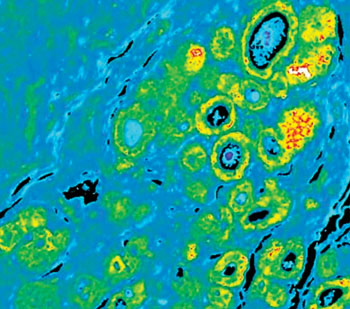Aggressive Breast Cancer Identified with Fluorescent Technique
By LabMedica International staff writers
Posted on 21 Jul 2016
Ductal carcinoma in situ (DCIS) of the breast is the most common type of non-invasive breast cancer and in DCIS, epithelial cells proliferate within ducts, which are surrounded by a double layer of myoepithelial cells and basement membranes.Posted on 21 Jul 2016
Although epidemiological studies propose aggressive and non-aggressive forms of ductal DCIS, they cannot be identified with conventional histopathology and because of this, to be safe, most patients undergo aggressive treatment.

Image: The new BRIM technology enables pathologists to identify whether a DCIS is aggressive or not. In this image of a DCIS sample, the biomarkers CD44hi/CD24lo, reveals intraductal cells of aggressive cancer that are highlighted (Photo courtesy of University of Michigan Health System).
Scientists at the University of Michigan Medical School (Ann Arbor, MI, USA) used a new method, called biomarker ratio imaging microscopy (BRIM), to evaluate the co-expression of biomarkers correlating and anti-correlating with breast cancer aggressiveness in a retrospective study of DCIS samples. BRIM combines traditional microscope techniques that pathologists use to examine tissue with mathematical analysis. The technique compares levels of different biomarkers, which can be seen as different fluorescent colors in stained tissue under a microscope.
Fluorescence microscopy was performed using a TE2000-U inverted microscope (Nikon, Melville, NY, USA) and an Andor iXon camera (Andor Technology, Belfast, UK) with 100 W mercury lamp. The investigators looked at biopsy tissue samples from 23 patients with DCIS. They used fluorescent imaging, where the tissue samples are stained, to identify key biomarkers. Each biomarker was stained a different color. They then entered the images of the stained tissue samples into a computer that calculated the levels of different biomarkers in each pixel. In cancer, some biomarkers are present in high levels while others are less prolific. BRIM uses the ratio of these different levels to form an image of improved contrast.
The BRIM method found 22% of the samples had low ratios of cancer versus non-cancer biomarkers, suggesting those lesions were very slow-growing and non-aggressive. They note that an advantage of BRIM is that it uses several biomarkers rather than relying on only one. They decided which biomarkers to use after an extensive literature search. The authors concluded that the ability to stratify DCIS lesions and to identify potentially non-aggressive and aggressive lesions raises important issues in addressing overtreatment in breast cancer. BRIM is particularly attractive because it could be integrated into clinical pathology practices. Moreover, this approach may be useful in the cytologic study of aspirates in breast cancer and in peritoneal fluids in ovarian cancer. The study was published on June 1, 2016, in the journal Scientific Reports.
Related Links:
University of Michigan Medical School
Nikon
Andor Technology




 assay.jpg)








